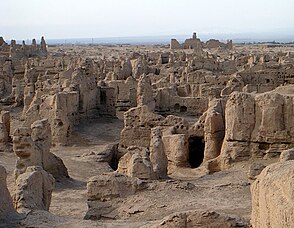Jiaohe (ruined city)
| Jiaohe (Archaeological Site) |
|
|
View over Jiaohe |
|
| meaning | Capital of the former Cheshi Empire |
| Construction year: | {{{Construction year}}} |
| founding | 108 B.C.E. |
| Heyday | |
| Destroyed | 2nd half of the 13th century |
| Given up | |
| discovery | Late 19th century |
| Location: |
Turfan Xinjiang , People's Republic of China |
| Location: | 42 ° 57 '2 " N , 89 ° 3' 50" E |
| Directions | |
| opening hours | |
| entry | |
| Uighur name | |
|---|---|
| Arabic-Persian (Kona Yeziⱪ) : | يارغول قەدىمقى شەهىرى |
| Latin (Yengi Yeziⱪ) : | Yarƣol ⱪədimⱪi xəⱨiri |
| Cyrillic ( Soviet Union ): | Ярғол қәдимки шәһири |
| Pronunciation in IPA : | [ jarɣoɫ qɛdimqi ʃɛhri ] |
| other spellings: | Yarghol, Yarghul |
| Chinese name | |
| Abbreviation : | 交河故城 遗址 |
| Traditional characters : | 交河故城 遗址 |
| Transcription in Pinyin : | Jiāohé gùchéng yízhǐ |
| Wade-Giles transcription : | Chiao-ho |
The ruined city of Jiaohe or Old Uighur-Mongolian Yar-Khoto ( Chinese 雅尔 湖 故城 , Pinyin Yǎ'ěrhú gùchéng ) is an archaeological site in the area of the city of Turfan in Xinjiang, China. It is located about 10 km west of Turfan on a 30 m high rock plateau in the Yarnaz Valley .
history
The city has a very long history and flourished from the time of the Sixteen Kingdoms to the time of the Northern Dynasties in the Gaochang Empire and the early Tang period. The ruins of former private and administrative buildings can be seen, on the northern edge the remains of two Buddhist monasteries and a large stupa can be seen.
According to historical reports, the city was from 108 BC. Until 450 BC the capital of the former Cheshi Empire ( Cheshi qian wangguo车 师 前王国 ), one of the thirty-six empires of the western regions . The city was already used as a fortress by the Chinese in the Han period. In the early years of the Tang Dynasty, the Anxi Governorate Command Office , the highest military and administrative body in the Western Region ( Xiyu ), was stationed here (640-658) and was later relocated to Kuqa . The city burned down in the second half of the 13th century.
The site was explored by the Russian Dimitri Klementz at the end of the 19th century and by Huang Wenbi in the late 1920s .
The site has been on the list of monuments of the People's Republic of China in Xinjiang (1-155) since 1961, and since 2014 it has been part of the UNESCO World Heritage Site entitled Silk Roads: the Road Network of the Chang'an Tianshan Corridor .
literature
- Dimitri Klementz : "Turfan and its antiquities." In: News about the expedition to Turfan equipped by the Imperial Academy of Sciences in St. Petersburg in 1898. Issue 1. St. Petersburg 1899
Web links
- Jiaohe
- Anterior Cheshi Kingdom, CORONA satellite photograph over the Jiaohe city ruins (29 / Sep / 1966) (Engl.)
- Relics of the Ancient Town of Jiaohe (English)
- Jiaohe gucheng (Chin.)
Footnotes
- ↑ Also called Gushi 姑 师.
- ^ Silk Roads: the Routes Network of Chang'an-Tianshan Corridor. In: whc.unesco.org. UNESCO World Heritage Center, accessed February 7, 2019 .

